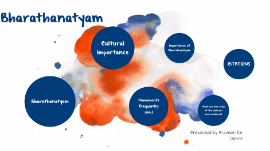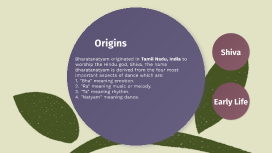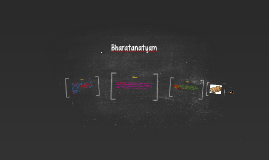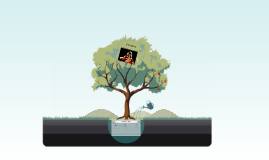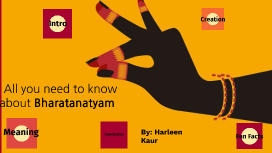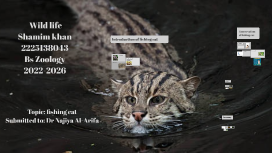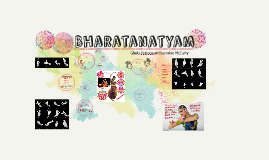Bharatanatyam
Transcript: Bharatanatyam Samantha Brugman Dance History Research Project April 25, 2023 Origins Bharatanatyam originated in Tamil Nadu, India to worship the Hindu god, Shiva. The name Bharatanatyam is derived from the four most important aspects of dance which are: 1. "Bha" meaning emotion. 2. "Ra" meaning music or melody. 3. "Ta" meaning rhythm. 4. "Natyam" meaning dance. Origins Shiva Name translates to "Lord of Dancers" or "King of Actors." Shiva is regarded as the creator, preserver, and destroyer of the universe and represents the cycle of time. Shiva Early Life Bharatanatyam is the oldest classical dance in India. It is over 2,000 years old, dating back to 300 B.C.E. Early Life Historical Purpose Purpose Originally, Bharatanyam was a temple dance for women. The Hindu Temples in South India had dancers and priestesses called Devadasis. They lived very strict and celibate lives forbidding them to have families. The Devadasi tradition eventually faded away when the dance entered the royal courts. The dancers were now called Rajanartakis, royal mistresses to the men. Modern Dancers Modern Dancers Bharatanatyam is an expressive form of dance, which calls for the demonstration of various poses, gestures, movements and facial expressions. Today, it is commonly performed during one’s aarangetram, or on-stage debut of a classical dance and music student. Many Indian classical dance forms require their students to perform an arangetram, which can occur at any time of the day. A bharatanatyam program performed by one dancer usually lasts two hours without interruption. Pictures Pictures Learning Stages This style of dance requires observing other dancers and taking classes. It takes years to become an expert in tapping, stretching, balancing, sliding, and jumping, all of which are the basic footwork for Bharatanatyam. Stages Dance Divisons Dance Divisions Bharatanatyam dance is broken down into three very broad divisions: Nritta, Nritya and Natya. 1. Nritta: The technical aspect of the performance in which the dancer performs movements with particular attention to speed, pattern, form, range and rhythm without the introduction of any interpretive elements. Dance Divisons Dance Divions 2. Nritya: The aspect of the dance in which the dancer incorporates spiritual themes, feelings, and expressive gestures. In order to convey the Nritya, the body movements and gestures are typically slower and harmonized with the musical notes of the musical piece. Dance Divisions Dance Divisions 3. Natya: Conveyed with the dancers maintaining particular body movements for specific characters which are communicated through interpretive dance. Professional Performance Dance Locations This dance is most popular in southern India. However, there are schools all over the USA for those interested in taking classes or competing in competitions. Locations Native Dress Clothing Includes: 1. Saree Blouse (Upper part) 2. Pyjama (Lower part) 3. Small Fan (Waist) 4. Pallu (Drape over upper body) Customs Jewelry Jewelry Includes: 1. Jumka (Earring with upward extension) 2. Oddiyanam (Waist band) 3. Nathni (Nose ring) 4. Long Mala (Long necklace) 5. Short Mala (Choker) 6. Vaanki, Chudiya, Ghungroo, Mattal, and Chandra (Hair ornaments) 7. Bindi (Red circular mark) Jewelry Makeup Makeup Traditional makeup features defined brows, a tri-coloured eyeshadow, winged eyeliner, and red lipstick. Dancers also wear red dye on the tips of their fingers and toes known as alta or mahavar. Belief System and Politics At the start of British colonial rule, the invaders viewed the Devadasis of South India as disgraceful. They instituted a ban on classical Indian art forms, thus ending the custom of temple Bharatanatyam performances. Beliefs Beliefs and Politics Continued It wasn't long before classical art revivalists began working together to resurrect Bharatanatyam. Lawyer and activist Krishna Iyer became involved in the fight to revive this traditional style of dance until he was incarcerated on charges of nationalism. While in prison, Iyer advocated for the renewal of Bharatanatyam dance with theosophist and choreographer, Rukmini Devi Arundale. Later, the two of them founded the Madras Music Academy where they worked with the community to save Bharatanatyam dance, among other traditional art forms. Beliefs Conclusion This revered classical dance style continued to grow in popularity as more and more students took up the study. Today, the Bharatanatyam dance is performed and celebrated all over India, as well as abroad, and is known as one of the most prominent Indian dances. Conclusion






